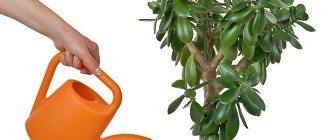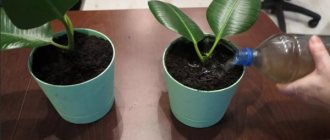Briefly about care
Temperature in summer +18º - +25º, in winter from +16º Air humidity is high Lighting is moderately bright, diffused Where to put the eastern, south-eastern, western, south-western, southern window sill Watering in summer 2 times a week, in winter - 1 time a week soil with sand and coal Feeding and fertilizing once every 14 days from spring to autumn with organic and mineral preparations Replanting annually in spring Propagation by cuttings, layering, seeds
Location and watering
In order for the ficus to grow quickly and actively gain green mass, you need to take care of its comfort. The following factors need to be taken into account:
- Location and lighting. When choosing a place where a plant will live, it is necessary, first of all, to start from how light it is in the room. Ficus benjamina loves bright, rather intense lighting, but excessive exposure to ultraviolet radiation is harmful, so it is better to protect your evergreen pet from direct sunlight. The priority should be slightly diffused light. The best places are indoors where the windows face the west or east, since on the south there is too much light, and on the north there is too little.
- Temperature. Despite the tropical roots of the ficus, it “with the character of a true northerner” endures even the harshest winter. The main thing is that the room temperature does not fall below 16 degrees Celsius. In summer, temperatures around 18-23 degrees are considered optimal. In this case, the room must be regularly ventilated. Ficus needs fresh air, but in no case drafts, from which it must be carefully protected.
- Watering. Ficus benjamina is a “drinker,” especially in the hot season, so it is very important not to allow even the slightest drying out of the soil in which it lives. In autumn and winter, you can water once a week - this will be enough. Watering ficus benjamina in summer should be more frequent. If you don’t pay attention, the plant can “take revenge” with yellowed or even fallen leaves.
- Air humidity. With this factor, everything is a little more complicated, because it is difficult for humans to influence nature, but humidity can be increased by simply spraying the plant with water, almost daily. A kind of shower will be pleasant for the ficus, plus it will act as a preventive measure against various kinds of pests.
- Fertilizers. As a rule, after a long winter the plant becomes a little depressed, sometimes even slightly lethargic, which is due to a lack of minerals. A logical question arises: how to fertilize ficus benjamina? He really needs some nourishment. Two-week feeding with a special mineral complex, and the plant will quickly be reanimated and regain its former vitality.
- The soil. For ficus benjamina, it is important not only to choose the right fertilizer, but also to understand what kind of soil is needed. This plant prefers a slightly acidic or neutral environment. It is important to have good drainage. You can purchase ready-made store-bought soil, or you can make it yourself, using leafy and turf soil, as well as coarse sand and peat, in a ratio of 2:2:1:1, respectively.
How to care after purchase
When purchasing, it is important to carefully examine the ficus, make sure that the soil is not over-moistened and does not emit an unpleasant odor. Choose a comfortable place for the plant: well-lit, warm and windproof.
Try not to move it from place to place often. It is advisable to spray the leaves and water the soil with Gumi-20 (2 drops per 200 ml) and quarantine for a week away from other flowers.
Replant no earlier than two weeks later to allow the flower to get used to the new conditions. If the plant does not get sick during this period, it is advisable to replant it, since store-bought soil is not intended for long-term cultivation.
After transplantation, you cannot use fertilizing for a month. Adjust watering: during the adaptation period, it is especially important not to overwater the ficus.
Don’t worry if you can’t perfectly comply with some conditions for caring for the plant: ficus benjamina is quite unpretentious and will forgive you for mistakes.
6. Fertilizers and fertilizing
Fertilizers and fertilizing for Ficus Benjamin are very important. Especially during the growing season, when foliage is actively growing. In spring, it is useful to feed with nitrogen fertilizers; choose special ones for ficuses and feed once every 2 weeks. Nitrogen is responsible for the growth and color of leaves. In addition, ficus also needs potassium, phosphorus and calcium - these are the main elements.
Organic fertilizers will also be useful and can be used successfully. I especially recommend bird droppings, they contain a lot of useful substances, use them in the form of a solution. Wood ash contains potassium and phosphorus and is ideal for fertilizing.
A useful infusion can be made as follows: pour 1 tsp. ash in 1 liter of boiling water, leave for about a week and water the ficus. You can also dust the soil and ficus leaves with ash, this will protect the plant from pests. Feeding is very useful, the main thing is compliance with proportions and regularity.
Important: fertilizing is done only on moist soil, to avoid burns to the root system. In order for the ficus to fully develop and delight with its appearance, it is necessary to provide it with sufficient nutrition, and competently combining mineral and organic fertilizers, that is, in a comprehensive manner.
Foliar feeding (on the leaves) from a spray bottle is also welcome. Feed ficus benjamina frequently to form a beautiful, lush crown.
FAQ
Is it possible to leave without care while on vacation?
It is not advisable to leave the ficus for longer than 1 week. At this time, it should be removed from the windowsill so that the plant does not get burned if it is very sunny in your absence. And ask your friends to water your plant. Read more about watering here.
What to do if ficus benjamina drops leaves
The plant gets rid of old leaves within the normal range. However, just in case, adjust the temperature in the room and provide additional lighting. Sometimes a plant falls off if it is moved to a new location or due to drafts.
Or the reason may be more serious: the roots have rotted from excessive watering. In this case, you need to remove the ficus from the pot, cut off the spoiled roots, sprinkle the sections with crushed activated carbon and replant them in a smaller pot with a complete replacement of the soil.
Flowers on ficus benjamina: is it possible?
Rarely blooms at home. If, nevertheless, pea-shaped inflorescences appear on it, then it is better to cut them off, especially if the plant is in poor condition: the ficus spends too much energy on flowering.
What ficus benjamina can be: varieties and forms
In tropical regions, Ficus benjamina grows outdoors like a regular street tree and can reach 30 m in height. Its ability to tolerate pruning makes it very popular as a hedge plant in California.
Alley of ficus Benjamin
In our latitudes, ficus benjamin is grown in pots and containers. With long branches and glossy green or variegated leaves, this plant can become a real designer decoration for an apartment or office.
At home, with proper care, Benjamin's ficus can also grow into a real indoor tree.
If you do not replant the ficus into a large pot, then it will remain just such a compact plant for the windowsill
Moreover, you can choose from many varieties.
- Traditional varieties with green leaves: Danielle (Daniel), Monique (Monique), Exotica (Exotica), Anastasia (Anastasia).
- Among the variegated (variegated) are especially popular: Starlight (Starlight), Safari (Safari), Nina (Nina).
- And these varieties boast original curled leaves: Barok, Buklee, Iren.
- Small-leaved ficuses also do not give up their positions: Natasja (Natasha), Kinky (Kinky).
Ficus Benjamin - small-leaved variety Kinki
An interesting feature of Ficus Benjamin is the ability of its shoots to grow together upon contact. By planting several cuttings nearby and, as they grow, tying their stems together or braiding them into a braid, rope or openwork design, you get a ficus on a trunk. That is, one tree with an intertwined trunk. You can also grow a ficus on a trunk from one cutting, removing the lower branches as it grows. But such a plant looks simpler and often less original.
In order for the ficus stems to grow together, it is enough to connect them (weave them together or gather them in a bundle) and tie them with thread or wire to fix them. After some time, the shoots will grow together and the clamp can be removed.
Spraying
Requires daily abundant spraying, especially during periods of low humidity: hot summer and heating season. To increase air humidity, you can place a saucer with water and expanded clay next to the ficus.
In the hot season, give the plant a shower - after that, do not rush to return it to the windowsill, but first let it dry a little so that sunburn does not appear on the leaves.
For spraying, use settled water at room temperature. Wipe dusty leaves regularly.
How to water a ficus in winter at home
If you do not reduce the frequency of watering in winter, the leaves on the tree will instantly fall off. Leaves should be sprayed with water from a spray bottle all year round. Ficuses love humidity very much. Sometimes you can give your pet a warm shower (not hot).
In winter, our apartments are heated intensively and the air becomes too dry. This is harmful for the ficus, so you should take the necessary measures to humidify the air in the room with the plant.
Watering ficus in winter:
- Ficus needs to be sprayed with water at room temperature.
- It is allowed to use special humidifiers that can be found on sale to humidify the air.
- If in winter the air in the room is very dry due to powerful heating devices, then it is recommended to fill the trays.
- To humidify the air near the plant, a mini fountain is well suited, which will also serve as an excellent interior decoration.
- If it is not possible to purchase a humidifier or fountain, it is recommended to place a water tank next to the ficus.
A specially constructed small greenhouse will also help protect the plant from excessive dry air in winter. In a poorly lit room where there is not enough moisture, the plant will lose leaves. In such unfavorable conditions, the leaves may also turn yellow. If, after discovering this ominous sign of a plant’s malaise, no action is taken, it will inevitably die. This is why it is necessary to ensure sufficient lighting from the very beginning.
Place the plant in a bowl of water. Place the bag on the plant and tightly wrap the edge of the bag with thread, preventing air from passing through.
The quality of water used for irrigation is also important for proper care of the tree in cold weather. It is not recommended to use tap water for this purpose. It is advisable to water the plant only with pre-settled water heated to +30 degrees.
Illumination
Loves moderately bright diffused lighting. Grows well on windows facing east or west.
Install shading on southern window sills - hang curtains, blinds or cover the window with film, which can be bought at a hardware store - otherwise, due to direct sunlight, burns in the form of light spots may appear on the ficus.
When placing the ficus on a north window, provide it with additional lighting in the form of a phytolamp, otherwise its branches will become thinner and it will grow poorly.
Varieties with dark leaves tolerate partial shade well, while variegated varieties need bright light due to the low amount of chlorophyll.
Suitable soil mixture
A neutral or slightly acidic substrate with high fertility is best. You can purchase a universal soil for decorative foliage plants; a substrate for palm trees or mulberry plants is also suitable.
Or prepare the soil mixture yourself. To do this, you need to mix equal parts turf and leaf soil, add sand and peat or charcoal.
To check the acidity, sprinkle a damp lump of soil with soda: if gas is released, then the soil is highly acidic. Moisten another lump of earth with vinegar: if the substrate hisses, the environment in it is alkaline.
Neutral soil will not give any reaction to any of the manipulations. You can put ash to eliminate the acidity of the substrate. Line the bottom with a layer of expanded clay for drainage.
Top dressing
Use mineral (Epin at a dosage of 1 ml per 5 liters of water) and organic (manure at the rate of 1 g per 1 liter of water, bird droppings - 5 g per 1 liter of water) fertilizer for ficus or ornamental foliage plants 2 times a month from March to September.
It is advisable to alternate them. You can not only sprinkle the soil with fertilizer, but also add it to the water for spraying the leaves and generously moisten both the foliage and the trunk.
In winter, give the plant a break from fertilizers to provide it with an artificial dormancy period. It is also better to refrain from fertilizing for a month after transplantation.
In addition to chemicals, you can also use folk remedies: dilute 1 tbsp. sugar in 1 liter of water and use it for watering (it is enough to apply this fertilizer twice a season).
Flowers on Ficus Benjamin: is it possible?
Ficus benjamina is an ornamental deciduous plant, but it is also capable of blooming. Although this happens extremely rarely at home, as a rule, it blooms and bears fruit in its natural environment or in large greenhouses. He doesn't do this in a standard way. In the ficus Benjamin, like its closest relative the fig, small rounded inflorescence formations appear in the axils of the leaves - syconia, within which flowers are located. Syconias look more like berries than inflorescences, so many people mistake them for fruits. They do not have any special decorative effect, so there is no point in regretting that your Ficus Benjamina does not bloom.
This is how ficus benjamina blooms
Transfer
A plant up to 4 years old must be transplanted into a new pot every year in the spring. Select the diameter of the pots 2-3 cm larger each time.
An adult plant can be left in an old pot, partially replacing the soil in it when the roots become crowded. This can be understood by the roots peeking out of the drainage holes and the rapid drying out of the soil.
A ficus older than four years old requires transplanting into a new pot only if the roots have completely entwined the earthen ball and the substrate dries out quickly after watering.
We replant using the transshipment method. To do this, take the flower out of the old pot and replant it in new soil, without shaking the old substrate from the roots too much. Place a layer of expanded clay on the bottom of the flowerpot to ensure drainage.
Sprinkle with a fresh layer of soil. In hot weather, you can water the plant a little right away, otherwise wait a few days.
Important: after transplanting, remove fertilizing for a month.
How often to water a ficus
During the period of active growth and development, ficus requires regular watering. In the autumn-winter period, it is recommended to reduce watering and water it no more than once a week.
When watering the plant, you should not overdo it and fill the ficus with water. This can be seen because when overflowing, water will collect in the pan. Excess moisture can lead to rotting of the roots. If there is a lack of moisture, the ficus can instantly shed its leaves. Therefore, when watering this plant, you should adhere to the principle of the golden mean.
Watering rules
Recommendations on how to properly water a ficus:
- Change watering regimes depending on the season. The quality of its growth will depend on how often you water your ficus.
- Clean water is used for watering ficus, at a temperature of 20-25°C.
- When irrigating the plant, the root area of the soil should be completely wet.
- The tree should be moistened early in the morning or after sunset.
To remove excess moisture, it is necessary to provide drainage at the bottom of the tub. Crushed red brick or expanded clay is used as drainage.
What you water your ficus with is of great importance. The liquid for irrigating the plant should be at room temperature at any time of the year. Using very warm or cool water will damage the roots.
Peculiarities
The watering schedule depends on several factors:
- Season. The irrigation regime varies depending on the time of year.
- Type of plant. Some species have individual moisture requirements.
- Age and size of the tree. The amount of water filling depends on these parameters.
- Soil quality. You need to choose light soils that allow moisture to pass through well. If the substrate does not meet the specifications, the watering conditions are adjusted. Over time, you need to transplant the tree into another soil.
With improper and irregular watering, the tree begins to deteriorate. The leaves turn yellow completely or at the edges, dry out or fall off completely.
Ficus trees need to be watered more often and more abundantly if they are tall and have a developed crown. Then there will be enough water for the development of the root system and shoots along the entire length.
What kind of water is suitable
Rain, melt and spring water are excellent for trees. It has unique natural properties. Tap water can be used. The main condition is low liquid hardness. To prevent heavy salts and harmful impurities from getting into the soil, the water must be settled. Another simple way to purify water is freezing and thawing. If you pass a liquid through a reverse osmosis filter, it will be stripped of absolutely all salts. This water is not used for plants.
During the period of growth activation (spring - early autumn), every 10-15 days it is necessary to water the ficus with water with the addition of liquid fertilizers. They will enrich the soil with the necessary microelements.
Water taken from the tap must be settled or filtered before watering. Otherwise, lime, which is contained in large quantities in tap water, can harm the plant. During settling, the water will heat up to the required temperature, and the chlorine included in its composition will have time to evaporate.
To free water from excessive hardness, it is useful to boil it. After this, it should cool down to ambient temperature. While the liquid cools, excess lime will gradually settle to the bottom. Therefore, when further pouring water into the watering container, you must be careful. It is not advisable to shake the vessel.
Residues of liquid with a high concentration of lime must be disposed of. Rainwater or melted snow can be used to moisten the soil. To obtain melt water, you can also freeze it in the freezer and then melt it at room temperature.
It is acceptable to use aquarium water to water the ficus.
When using untreated tap water for irrigation, an unsightly white coating may appear on the leaves and surface of the soil. And if the surface layer of soil can be easily removed and clean earth poured in, then this coating is difficult to remove from the foliage, and the appearance of the ficus may suffer.
How much water does a flower need?
There is no strict amount of water. It all depends on the size of the tree, the pot and the amount of soil. On average, it is necessary to moisten 2-3 cm deep into the soil. It is necessary to evenly moisten the lump of earth, do not pour water into one place, making a funnel in the ground. After watering, the soil is carefully loosened, trying not to damage the roots and the area of soil near the tree trunk.
Where to put
On the east, south-east, west or south-west window or away from the window if it is on the south side.
In summer, you can take the ficus outside, onto a balcony or onto a veranda, but if night temperatures drop below +16º, it is better not to do this, otherwise the plant may catch a cold.
Ficus with monochromatic leaves tolerates partial shade well, but a plant with spotted and white leaves must be placed in the light: they do not produce chlorophyll well. Keep the flower away from drafts and radiators.
9.Use of ficus benjamina in the interior
Ficus benjamina is distinguished by its small, graceful foliage and luxurious crown. Thanks to this and the ability to create various forms, ficuses are considered one of the popular plants in indoor floriculture. Interior designers are very fond of this plant, because thanks to it you can create a unique atmosphere in the room. Ficuses will fit perfectly into any style, be it classic or baroque, modern or Provence. The main thing is to choose the right place for it, because the flower is considered a symbol of prosperity and wealth.
According to Feng Shui, Ficus Benjamin is good to place in the south-eastern part of the house. And of course, create all the conditions for a comfortable stay for this evergreen beauty. Using certain techniques, ficus can be shaped, giving the plant different looks: bonsai, standard or braid. In short, Ficus Benjamin is a plant from which you can create a unique specimen with a little patience and creativity. I wish you success.
With respect, Nadezhda
Pruning and crown formation
Ficus is pruned to give it an aesthetic appearance and to rejuvenate it. In spring, shorten the branches, leaving 10-15 cm and thin out the crown, especially if the branches grow inside the bush.
You can also remove all side branches, forming one strong trunk. Treat cut stumps with potassium permanganate or activated carbon powder. It is also possible to weave the stems into a braid and create a ficus bonsai.
Braiding stems
This should be taken care of even at the stage of planting cuttings in a pot. Place 3-4 seedlings at once in one pot. They must be at least 13 cm long so that they can be braided.
Trim the side branches from the trunks and water the plant 10 hours before weaving begins. The density of the braid can be adjusted by inserting sticks into the gaps, which will need to be removed later, when the plant gets used to the new shape.
Tie the braided fragment with woolen thread to fix the branches in the desired position. As the ficus grows, add more braiding.
Sometimes, when the trunk reaches a great length, it is necessary to install a support so that the ficus does not fall to one side. To do this, place a stick in the pot and tie the stems to it in one or several places, depending on the height of the plant.
Compositions in bonsai style
To do this, it is important to immediately choose the right pot: it should be wide and low, like a tray, and always have holes in the bottom for drainage. The Exotic variety is best suited for forming a bonsai (it has developed roots, a beautiful trunk, small leaves, and it grows quickly).
- At the bottom we lay out a layer of drainage, a layer of river sand and a layer of soil.
- We trim the roots so that they are not crowded in the pot and cut the branches to a length of 15 cm.
- We plant it in a substrate, water it and place it in partial shade for 2 weeks.
- As it grows, we trim the main trunk, making a cut above the upper bud so that the ficus does not stretch upward, but grows to the sides.
- As the roots and trunk grow, once a year we transplant it into a wider pot. When the trunk reaches the desired thickness, replanting can be stopped.
- To form curved branches, we tie them to the trunk with supports. Gradually they will learn to grow in a certain direction without outside help, and the tying can be removed. It is also possible to use thin wire with insulation, which is wrapped around the barrels, fixing them in the desired position. When the ficus learns to grow as required, carefully cut the wire and remove it.
Important: the soil in low, wide pots dries out faster, so it is recommended to water and spray the ficus daily in small portions.
Reproduction methods
Ficus benjamina can be planted by cuttings, layering appearing on the trunk, or grown from seeds.
The easiest way is to plant cuttings: this is the method that is most likely to be successful. It is best to do this in the spring.
Cuttings
To do this, we cut off a lignified cutting 10-12 cm long, wash off the juice from the cut and dry it, then make a notch on it to accelerate root germination.
Place the cutting in water so that the leaves do not get wet. To avoid rotting, you can dissolve ½ tablet of aspirin or activated carbon in water.
The root should emerge in 1-2 weeks. You can make a greenhouse by covering the plant with a glass jar.
After the roots have sprouted, we plant them in the soil and cover them with a plastic bag.
When a new shoot hatches, we remove the greenhouse. The cutting can be rooted directly in the soil, bypassing the stage of root germination in water.
How to propagate by layering
We make a round cut on the trunk and remove the bark, after which we apply wet sphagnum and wrap it with polyethylene. When roots grow in this area, you need to cut off the top and plant it in the ground.
Growing from seeds
The seeds can be soaked in water for a day, or they can be planted directly into the substrate in a dry form. The soil must first be wetted and the seeds must be buried to a depth of one and a half centimeters.
You can put the seeds on a radiator to speed up germination. The ficus should sprout in a couple of months.
Reproduction
Ficus benjamina is propagated by cuttings.
The best time for this is spring, when it becomes warm and all processes in the plant body proceed at an accelerated pace. But still, the process of root emergence in Ficus Benjamin cannot be called quick. Under favorable conditions (warmth, favorable humidity), spring cuttings take root in 2-3 weeks. In more difficult conditions, this process can take a month or more.
To propagate Ficus Benjamin by cuttings, do the following:
- Using a sharp knife, cut the apical young cuttings (non-lignified or semi-lignified) from the plant. The length of the cuttings should be 10-15 cm.
- A milky juice is released at the cut site - rinse it off under running water or immediately place the cutting in a glass of water for 1 hour. Then dry the cut in a dry place for several hours. Milky sap inhibits the emergence of roots in ficus, so you should not neglect to wash it off.
- Tear off the lower leaves on the cutting. When buried in soil or water, these leaves will most likely begin to rot, thereby spreading bacteria to the rooting cutting.
- To stimulate the formation of roots and make this process faster, dip a cut of the cutting in Kornevin. This stage is not mandatory, but highly desirable, especially in non-ideal rooting conditions.
- Place the cutting in warm water or bury it 1.5-2 cm in the ground. A more successful soil option is peat tablets, in which roots form faster.
- To root cuttings, choose a warm (more than 25°C) and bright place, without direct sunlight. High air humidity is also important - ideally about 80%. To increase this parameter, the easiest way is to build a greenhouse over the rooted cuttings, that is, cover it with a plastic cup, bag, etc.
After cutting, ficus cuttings are buried in the ground, where they will take root
. For reference:
In autumn and winter, the rooting of any plants, including ficuses, may not take place at all. At this time, the plant is preparing or is already dormant; another unfavorable factor is cold. The cutting will be in a half-asleep state and will most likely rot.
Diseases and pests
Ficus can get sick if it is not watered regularly, gets cold, is under- or over-fed, or is provided with insufficient or excessive light.
Lumps on leaves
You are flooding the soil too much. The roots can rot, so they need to be removed from the pot, cut off the damaged parts, sprinkled with activated carbon powder and replanted in fresh soil. As a preventive measure, reduce watering.
Leaves wither and curl
This is a sign that the plant is freezing. Remove it from a cold windowsill and avoid drafts. Another possible reason is low air humidity - start spraying the ficus.
The tips of the leaves turn brown
This indicates a lack of moisture. Start spraying the leaves and remove the ficus from the radiators. You can also increase the air humidity in the room by placing a saucer of water next to the flower, hanging a damp towel on the radiator, or purchasing an air humidifier.
Thinning of young shoots
This occurs with a lack of light and feeding. Place the ficus on a well-lit windowsill or purchase a phytolamp for it, and also start using mineral fertilizers (Agricola in a dosage of 1 tsp per 2 liters of water) once every 2 weeks.
Yellowing of ficus benjamina leaves
This is a sign that you are flooding the plant and its roots are beginning to rot. Remove the plant from the pot, remove bad roots, remembering to treat the wounds with charcoal powder, and then replant it in new soil. As a preventative measure, reduce watering.
Leaves become soft
This happens when the plant freezes. Remove it from a cold windowsill or place it on a stand. When airing, take it to another room.
Spots on leaves
Yellow or brown spots are sunburn. Do not expose the plant to direct sunlight; install a shade on the southern windowsill.
Yellowing along the edges of the sheet
The plant lacks fertilizer. Add nitrogen fertilizing (Agricola at a dosage of 1 tsp per 2 liters of water) once every 14 days.
The foliage is drying
This happens in winter due to lack of lighting and air humidity. Provide the ficus with additional lighting using a phytolamp and increase the number of sprays, or install an air humidifier in the room.
You can also increase the humidity using old-fashioned methods: place a saucer with water and expanded clay near the pot or cover the radiator with a damp towel.
Botrytis
A white coating on the leaves will indicate its appearance. Remove the damage and treat the leaves with a fungicide (Fitosporin in a ratio of 1:20). If a single spraying does not help, repeat it after 10-12 days. It is also recommended to reduce watering during treatment.
Cercospora
Dark spots on the back surface of the foliage. Because of it, the plant may wither. Remove damage, treat with furatsilin: dilute 1 tablet in 100 ml of boiling water, cool to room temperature and spray on leaves. Remove the plant until it recovers.
Anthracnose
The edges of the leaves dry out and brown spots appear. Remove damage, treat with copper sulfate: 1 tsp. dilute in 2 liters of hot water, cool to room temperature, spray the leaves and water the soil. Place in quarantine for the duration of treatment. Repeated treatment is carried out after 1.5 - 3 weeks. It is also important to reduce watering during the treatment period.
Sooty fungus
It is a dark film resembling a soot coating. Because of it, the plant cannot breathe normally, which is why it begins to grow more slowly and weaken. Wash off the plaque with a damp cloth and give the plant a warm shower.
Remove the affected parts of the plant and treat all its parts, including the roots, with Aktara fungicide, diluting 1 g per 1.25 liters of water. To prevent fungal diseases, you can water the soil once a month with a weak solution of potassium permanganate.
Mealybug
White fluffy lumps on cuttings. The roots can also be affected, but this can only be known during transplantation or if the plant begins to wither.
Wash off in the shower, covering the soil with a bag, treat with insecticide: Confidor at the rate of 1 g per 1 liter of water, spray the foliage and spill the soil, repeat the procedure with Aktara in a week at a dosage of 1 g per 1 liter of water.
Shchitovka
Brown tubercles on the back surface of the leaves. Rinse off in the shower, covering the soil with a bag, treat the leaves on both sides with Actellik (2 ml per 2 liters of water) 3-4 times with an interval of 7 days. The drug is toxic, so it is advisable to carry out the treatment outdoors.
Spider mite
It appears as small red and brown dots crawling along leaves and branches. At later stages of damage, they are indicated by the appearance of cobwebs on the plant. Rinse off in the shower, covering the soil with a bag, treat the leaves on both sides with an insecticide: Actellik (2 ml per 2 liters of water), Aktara (4 g per 5 liters of water), Fitoverm (10 ml per 1 liter of water). Repeat the procedure three times every 10 days.
Aphid
Small green or black insects that attack the inside of leaves. Treat the plant with a soap solution three times during the week or spray the leaves on both sides with an insecticide: a solution of Bordeaux mixture (100 g per 10 liters of water, use no more than three times at weekly intervals), pyrethrum (2 g per 1 liter of water, treat 3 times). 4 times with a break of 5 days).
Thrips
They can be identified by shiny white spots on the outside of the foliage. The insects themselves settle on the underside and have bodies up to 1.5 mm long that are brown, black or gray.
Adults can be removed with a vacuum cleaner, and larvae with a cotton swab. It is advisable to transplant the flower into new soil, first disinfect the pot or purchase a new one. Can be treated with chemicals: Agravertine (10 ml per 1 liter of water). It is important to spray the entire plant.
Nematodes
These are invisible insects that attack plants, causing their leaves to stop developing, wither and become spotted. The chemicals used to control nematodes are toxic and should not be used indoors. The best solution is to throw the plant away.
If you still have the opportunity to treat the plant in the fresh air: dilute Actellik (2 ml per 2 liters of water) and spray the entire plant, and also immerse the roots in the solution. After this, you need to transplant it into new soil, having first disinfected the pot and the place where the ficus stood. This can be done with a solution of potassium permanganate, vinegar essence or soda-salt solution.
To avoid damage by this pest, the soil must be calcined before planting. To do this, pour the soil into a basin and pour boiling water over it, then place it on a baking sheet in a thin layer and heat in the oven for half an hour at a temperature of 70-90 degrees.
How to care for ficus benjamina?
In order for this plant to be healthy, pleased with its glossy leaves and grow quickly, it is necessary to follow some rules of care.
Lighting
Ficus benjamina loves bright, diffused lighting; it looks best on western and eastern windows. If possible, take the plant outside or onto the balcony during spring/summer. Fresh air and plenty of light will definitely benefit the ficus. It will fluff up and accelerate its growth. However, it is better to shade it from direct sunlight, otherwise burns will appear on the leaves.
The variegated (variegated) varieties of Ficus Benjamin are especially demanding when it comes to lighting. With a lack of light, they lose their originality, their foliage becomes ordinary, green.
A caveat should be made here. Ficus benjamina can tolerate poor lighting for some time. That is, it can easily stand in your place somewhere in a dark corner for several months. It will not die, but some of the leaves will lose and their color will become dull. That is, as a necessary measure, temporarily, you can place the ficus in a place with insufficient lighting. But it cannot be placed there on a permanent basis.
Ficus benjamina should be placed closer to the window
Temperature
Ideal temperatures for Ficus Benjamin are 16-24° C. But deviations from this range by 4-5 degrees in one direction or another will not cause any particular harm. Try not to let the temperature drop below 10° C, otherwise the ficus will most likely begin to lose leaves. Not necessarily though. If your plant is acclimatized and hardened, then there may not be any negative effects even if the temperature drops to 5° C.
Note!
In winter, protect Ficus Benjamin from drafts. Make sure that it does not blow from an open window if it is frosty outside. Almost certainly, after frostbite, the ficus will drop all its leaves. And it will grow them again only in the spring. Best case scenario. At worst, the plant may die.
Watering and humidity
It is necessary to water Ficus Benjamina at home sparingly, since excessive soil moisture often leads to rotting of the root system. Between waterings, the soil in the pot should dry out by 1-2 cm. In winter, more drastic drying can be allowed.
For irrigation, use only warm, settled or boiled water. And this is a very important condition. Ficus benjamina is very sensitive to chemical impurities that tap water contains, such as chlorine and fluoride. Therefore, it is necessary to either settle the irrigation water (at least 8 hours) or boil it.
Another important parameter for the health of Ficus Benjamin is high air humidity. In summer and when central heating is on, regularly spray its leaves with warm water. In autumn, on cold days, when the heating is not working or is not turned on at full power, spraying should be avoided.
Spraying Ficus Benjamin is an essential part of caring for it.
Note!
In winter, do not place Ficus Benjamin near radiators. Too dry air causes leaves to fall.
Soil and replanting
The most important requirement for soil: its good water and breathability properties. When watering, water should flow quickly through the drainage holes, without stagnating near the roots. If the soil is too heavy and retains moisture for a long time, the roots of the ficus may suffer from putrefactive processes.
The growth rate of Ficus Benjamin, which lives in a pot at home, is relatively slow. Therefore, young plants are traditionally transplanted into a larger pot once a year, in the spring. Adult plants need replanting much less often - once every 3-4 years.
About ficus transplantation and further care for it, watch the video:
What to feed?
In the spring-summer period (from March to September inclusive), the Benjamin ficus enters a phase of active growth: foliage grows and young shoots appear. All this requires nutrition, which may not be enough in the soil. Therefore, to ensure full development of the ficus at this time, feed it with fertilizer with a high nitrogen content every 1-2 weeks. In stores, such fertilizers are usually sold with the note “for decorative deciduous plants.” There are also fertilizers specially designed for ficus, for example, Agricola - “For ficus” with a ratio of 23:10:16 (N:P:K).
You can feed ficus with any fertilizer with a high nitrogen content.
Note!
Root fertilizers are applied in moist soil. That is, first you water the plant with clean, settled water, and after 15-20 minutes - with water with diluted fertilizer. This approach will reduce the risk of chemical burns to the roots.
In autumn and winter, Ficus Benjamin, growing at home, does not need to be fed, since all vital processes slow down during this period. The plants enter a resting stage.
Ficus Benjamin varieties with photos
There are not very many species, and in appearance they do not differ much from each other. Lovers will be able to choose a flower that suits their taste more than others.
Important: the more light spots on the leaves, the more demanding the ficus is in terms of lighting.
Exotic
It is compact, has dark green leaves with wavy edges. This is the most unpretentious species, which is better than others for beginning gardeners.
Daniel
It has large, dark green leaves, similar in appearance to the exotic variety.
Monique
The light green leaves have creamy golden spots along the edges. More demanding of care than the previous two types.
Reginald
Outwardly it resembles the Monique variety: light leaves with a smooth edge and light spots.
Kinky
Dwarf ficus with shiny small leaves with a light edge (in an adult plant it takes on a pinkish tint). It responds well to pruning, allowing you to create fancy shapes.
Baft
It has a wide light border along the edge of a dark green leaf, which looks unusual and attractive.
Twilight
It is distinguished by almost completely white leaves. The most demanding of lighting: light leaves lack chlorophyll, and the plant will wither in the shade.
Baroque
The leaves are small and have an unusual, twisted shape. Suitable for those gardeners who like to stand out with original plants.
Signs and superstitions
Sometimes completely opposite properties are attributed to the plant. For example, in some countries he is considered a husband-wife, capable of getting rid of even an existing boyfriend, while in others, on the contrary, he is considered the keeper of the hearth.
It is interesting that for some reason such superstitions always concern only women, and no one tries to protect men from plants that can ruin their personal lives.
We advise you not to listen to any signs and grow this unpretentious plant in your home, which will take root even among inexperienced gardeners.











